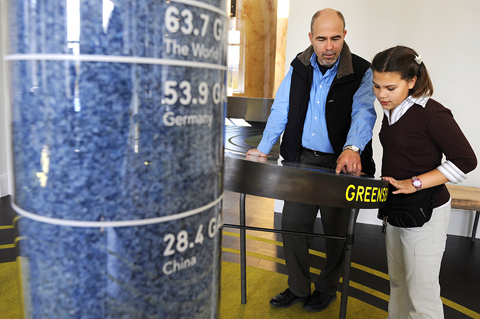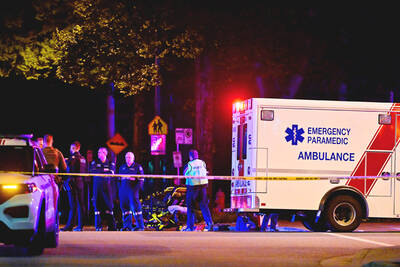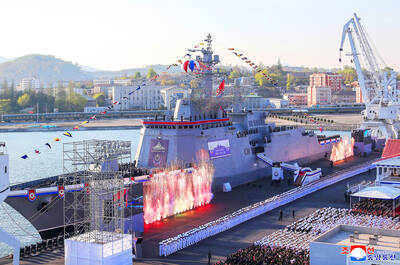Greensburg, Kansas, rebuilding from scratch after nearly being wiped away by a tornado last year, is quickly becoming a model for going green.
Along with Masdar City, a planned car-free community outside Abu Dhabi in the United Arab Emirates, and other developments, the rural Kansas town offers vivid examples of sustainable living in a “Green Community,” a new exhibit at the National Building Museum in Washington. The exhibit opened on Thursday and will run for a year.
“They are really making a wonderful opportunity out of an absolute tragedy,” curator and architect Susan Piedmont-Palladino said of Greensburg. “Masdar and Greensburg do make a really good pair because they’re both looking at the whole package of green technologies — from very old ways of doing things to high-tech ways.”

PHOTO: AP
Where windmills once dotted the Kansas landscape, Greensburg plans to embrace them again to harvest enough wind energy to power the town of about 700, which had twice as many residents before the tornado.
Greensburg gets only 56cm of rain a year, so street runoff and rainwater that hits buildings will be collected and used to irrigate plants, part of a master plan that “treats each drop of water as a precious resource,” said Stephen Hardy, a city planner with the architectural firm BNIM, which is helping with the effort.
And the town has resolved to build public buildings that meet the most stringent standards for efficient design. Even the John Deere dealership is pursuing certification from the US Green Building Council and plans to sell wind turbines for homes and businesses.
“Any time you’re trying to rebuild a town, there are huge economic hurdles,” Hardy said. “The fundamental shift in their thinking is they don’t want to build a building they’ll be paying for for 20 years. They want a building that will be paying them back.”
The Building Museum exhibit breaks some traditional rules by using no precious artifacts and few physical objects to tell the story of green communities.
Instead, it uses satellite photos, community snapshots, short documentaries and interactive displays on the myriad ways people can make their towns greener.
The center of the space is like walking through a huge bar graph.
Giant, transparent columns are filled with shredded tires or plastic bottles — materials otherwise headed to the dump. Marked on the columns are raw statistics on recycling or mass-transit use among various cities.
The numbers show Houston has the lowest recycling rate, with just 2.6 percent of the city’s trash being salvaged, while San Francisco, which has an organic composting program for food scraps, topping the chart at 70 percent.
“None of these issues are brand new,” Piedmont-Palladino said. “Ever since the Roman senate passed a law requiring water to be stored for dry periods, it sort of reminds us that ... it’s been the key to successful living forever. We have just forgotten.”
More than a dozen communities are noted in the exhibit and they offer a mosaic of green initiatives worldwide, Piedmont-Palladino said.
Atlanta, for example, is featured for its redevelopment of an old steel mill site in the walkable Atlantic Station development.
This is the Building Museum’s third in a series of green-themed exhibits, which have drawn record numbers of visitors despite the museum’s not being on the usual Washington tourism route.
Having small towns and big cities embrace environmentally friendly architecture and technologies will help change people’s minds about how realistic environmental building can be, Piedmont-Palladino said.
In Greensburg, the vision to go green has helped maintain an optimism that the town can indeed rebound from all it has lost.
“Ninety percent of the town was just gone overnight and yet the social fabric was intact, even without the buildings,” Hardy said. “That has driven them in a way that’s unlike any community I’ve worked with.”

Archeologists in Peru on Thursday said they found the 5,000-year-old remains of a noblewoman at the sacred city of Caral, revealing the important role played by women in the oldest center of civilization in the Americas. “What has been discovered corresponds to a woman who apparently had elevated status, an elite woman,” archeologist David Palomino said. The mummy was found in Aspero, a sacred site within the city of Caral that was a garbage dump for more than 30 years until becoming an archeological site in the 1990s. Palomino said the carefully preserved remains, dating to 3,000BC, contained skin, part of the

TRUMP EFFECT: The win capped one of the most dramatic turnarounds in Canadian political history after the Conservatives had led the Liberals by more than 20 points Canadian Prime Minister Mark Carney yesterday pledged to win US President Donald Trump’s trade war after winning Canada’s election and leading his Liberal Party to another term in power. Following a campaign dominated by Trump’s tariffs and annexation threats, Carney promised to chart “a new path forward” in a world “fundamentally changed” by a US that is newly hostile to free trade. “We are over the shock of the American betrayal, but we should never forget the lessons,” said Carney, who led the central banks of Canada and the UK before entering politics earlier this year. “We will win this trade war and

‘BODIES EVERYWHERE’: The incident occurred at a Filipino festival celebrating an anti-colonial leader, with the driver described as a ‘lone suspect’ known to police Canadian police arrested a man on Saturday after a car plowed into a street party in the western Canadian city of Vancouver, killing a number of people. Authorities said the incident happened shortly after 8pm in Vancouver’s Sunset on Fraser neighborhood as members of the Filipino community gathered to celebrate Lapu Lapu Day. The festival, which commemorates a Filipino anti-colonial leader from the 16th century, falls this year on the weekend before Canada’s election. A 30-year-old local man was arrested at the scene, Vancouver police wrote on X. The driver was a “lone suspect” known to police, a police spokesperson told journalists at the

North Korean leader Kim Jong-un has unveiled a new naval destroyer, claiming it as a significant advancement toward his goal of expanding the operational range and preemptive strike capabilities of his nuclear-armed military, state media said yesterday. North Korea’s state-run Korean Central News Agency (KCNA) said Kim attended the launching ceremony for the 5,000-tonne warship on Friday at the western port of Nampo. Kim framed the arms buildup as a response to perceived threats from the US and its allies in Asia, who have been expanding joint military exercises amid rising tensions over the North’s nuclear program. He added that the acquisition